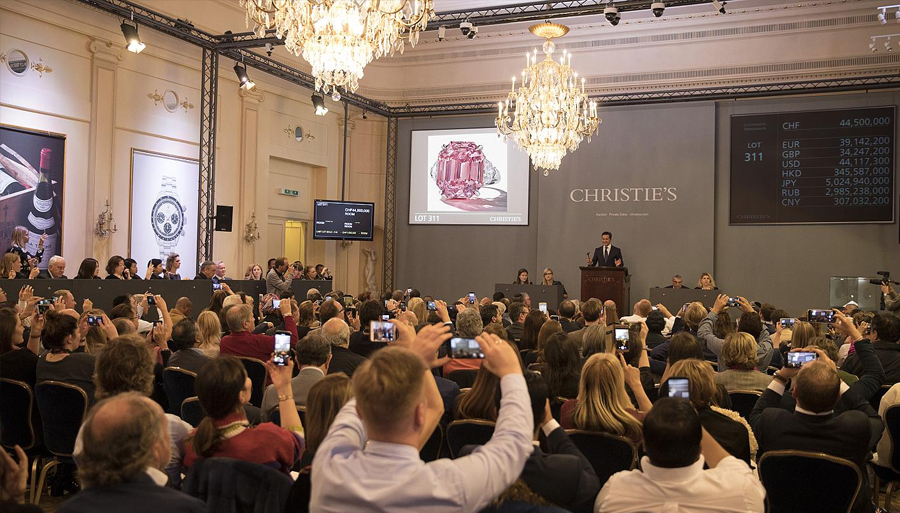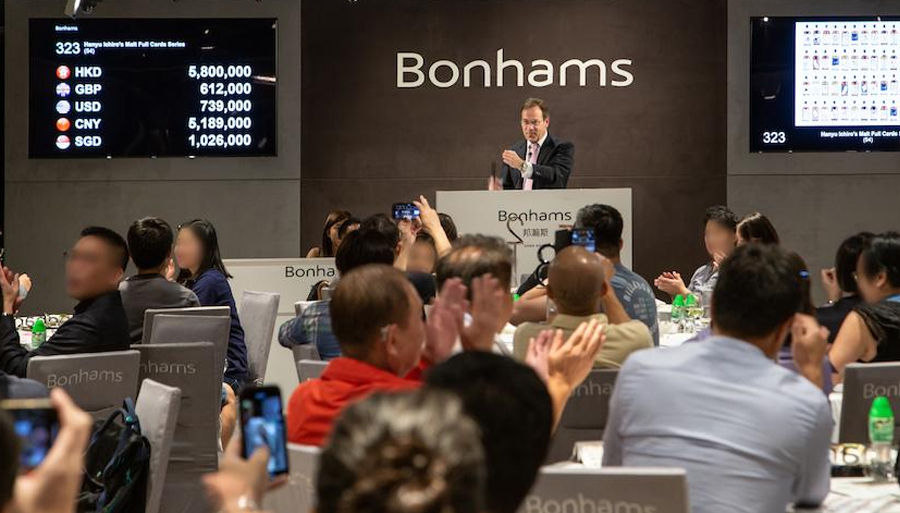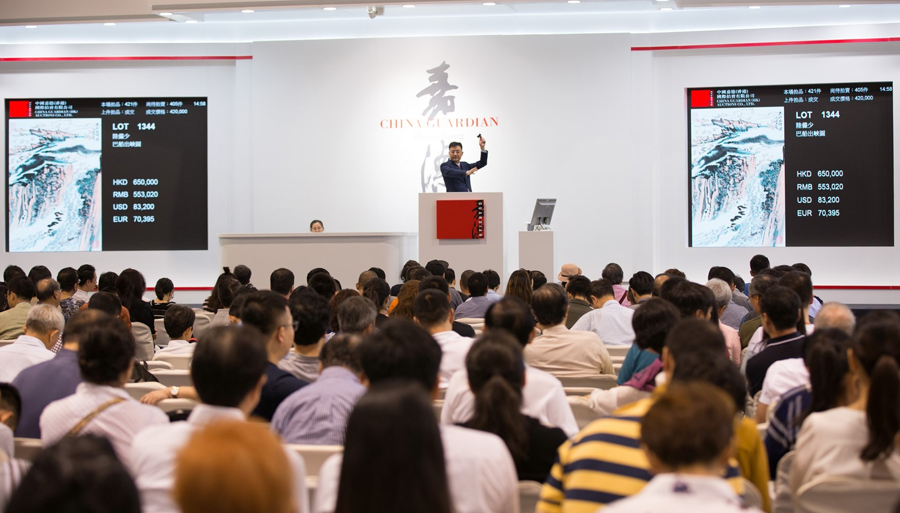The Business of Luxury Auction Houses
- 27th May 2020
- 2740
- 0

Going once… Going twice… Sold!
Before we understand the functions of an auction house, let us understand what an auction actually is. An auction is defined as a process of buying and selling goods or services by offering them up for bid, taking bids, and then selling the item to the highest bidder. Unlike regular contracts the process does not start with an “offer” but with an “invitation to offer”. The bidders may then make their offers, which may get acceptance in manifold ways, the nuances of which we discuss below. An auction house is the place/organization which facilitates the invitation to offer, receives the offers and deals with them in what is commonly understood as the buying and selling of assets. Those of the auction houses dealing with highly valuable items such as art and collectibles are the subject of this presentation. An auction house is often a company that conducts auctions, rather than a specific location where auctions are held. A person who conducts sales by auction is known as an auctioneer.
Honestly, auctions are theatrical maneuvers of business. The glamour and entertainment involved is an inherent part of the heightened exclusivity.
A Peek in the Past
Although auctions have been recorded in history from as early as 500 BC, auction was mentioned for the first time 1595 in the Oxford dictionary. The first auction house was Stockholm Auction House, Sweden, founded in 1674. Sotheby’s was established in 1744 in London and Christie’s began was opened in 1766. The London Gazette began coverage of the auctions from late 17th century and by the end of 18th century, these auction houses were printing their own sophisticated auction catalogues to broadcast details about the intricate items available. It seems these catalogues have only become more elaborate and refined with time as auction sales increase.
Types of Auctions
There are many types of auctions that unfold differently, their process distinct from each other. In this article, we’ll take a look at four of the major variants.
Absolute Auction
There doesn’t exist any minimum bid and all the buyers are free to compete in the auction, live. The property is sold to the highest bidder. This is the most common and widespread way of auctioning.
Minimum Bid Auction
The lowest acceptable price is predetermined by the seller and the auctioneer and the item cannot be sold until a bid reaches the minimum bid. The starting bid can start lower than than the minimum but it has to rise to higher, or at least equal to, the minimum bid for a purchase to take place.
Reserve Auction
In this type of auction, the “winning” bid can be rejected by the seller and auctioneer if it is not enough for them. The reserve is set by the seller (and can be modified during the course of the auction), of which the buyer has no knowledge.
Sealed Bid Auction
Bidders simultaneously submit their best offers which are reviewed privately by the seller and the auctioneer. So none of the bidders know the true intensity of the competition. The seller can accept the highest bid, reject them all and call for a final best bid, or negotiate with all the bidders.
The Big Five of the Biggest
Christie’s
Founded in 1766 by James Christie, it is today the world’s largest auction house. After being bought by the French billionaire Francois Pinnault, the owner of the Kering Group, Christie’s became a private company in 1988. Known as the ultimate portrayal of exceptional art and distinguished service, Christie’s has conducted some of the most widely known, high-profile auctions through the times.

Source : www.euronews.com
With a global presence in 46 countries with 10 sales rooms (London, Paris, Geneva, Milan, Amsterdam, Dubai, Zürich, Hong Kong, and Shanghai) around the world, Christie’s is now based out of New York. Their expansion in the developing luxury markets of India, China and UAE have been successful with sales in Mumbai, Beijing and Dubai.
Christie’s offers around 350 auctions annually in over 80 categories, encompassing diverse realms of fine and decorative arts, wine, collectibles, jewellery, photographs and more. The worth of their sales ranges from $200 to over $100 million and has an outstanding legacy of conducting private sales as well.
Some of Christie’s most celebrated sales include the “Salvador Mundi”, the famous painting by Leonardo Da’ Vinci, the personal notes of Albert Einstein, Elizabeth Taylor’s jewellery, Patek Philippe watch, in the Grandmaster Chime model and many others.
Sotheby’s
Established in 1744 in London, Sotheby’s became the first international auction house after opening offices in New York in 1955. It is listed as the oldest company on the New York Stock Exchange and is an indisputable element in the times and rise of auction houses.

Source : https://www.sothebys.com/en/about
Today, Sotheby’s global network comprises of 80 offices in 40 countries as it presents auctions in 10 different salesrooms, including New York, London, Hong Kong and Paris. Its varied portfolio of sales includes categories of fine art, retail, diamonds, automobiles, and wine. It also presents is clientele with the convenience of an assortment of private sales spanning over 70 categories.
Sotheby’s is at the forefront of modernisation and leading technological change as it fully utilises the new opportunities offered by the internet. Its venture BidNow enables live participation in its auctions online, from all corners of the world. Sotheby’s Financial Services is the world’s only full-servicing art financing company.
Sotheby’s most notable sales constitute of Edvard Munch’s masterpiece “The Scream” which in 2012, sold for a record-breaking $119,922,500, collections from, Jacqueline Kennedy Onassis, the Duke and Duchess of Windsor and David Bowie. Amedeo Modigliani's Nu couché (sur le côté gauche) which fetched $157.2 million in 1917 makes it the most expensive work ever to sell at Sotheby’s.
Phillips
Founded in 1796 by Harry Phillips, who was a businessman, innovator and showman, Phillips gained international avowal by auctioning pieces of prestige and prominence such as the paintings from the estate of Queen Marie Antoinette and household items of Napoleon Bonaparte. In 2018, the auction house announced that it sold $916 million worth of art and collectibles, the highest in its 220-year history.

Source : https://www.phillips.com/
The company has carved a niche for itself by specialising in the sales of the most riveting twentieth century and contemporary works of art, design, jewels, watches, photographs and editions. With auctions being conducted in its New York, London, Hong Kong and Geneva salerooms, the auction house’s global presence is a testament to its reputation of dynamic forward thinking defined by the aesthetic movements of the last century. Phillips also has regional representatives and galleries across Hong Kong, Jakarta, Seoul, Shanghai, Singapore, Taipei and Tokyo.
Phillips’ celebrated auctions include Pablo Picasso’s La Dormeuse (1932) sold for $57.8 million, Matisse’s bronze sculpture Nu Allonge 1 (Aurore) (1917) sold for $20.5 million and a pink gold Patek Philippe Ref. 2499 signed “Trucchi”, which achieved US$1.6 Million and became the most expensive watch Phillips has ever sold to an online bidder.
Bonhams
Bonhams was established in 1793 in London and now boasts of eight major auction venues and sales representatives in 25 countries. The sole internal auction house which is proudly privately owned, even today, by British hands is known for its 21st century auctioneering. The company bestows equal importance to both, the modern and the antique. In 2018, the company was acquired by the UK-based Epiris, a private equity company.

Source : https://www.bonhams.com/press_release/28487/
Bonhams holds more than 400 specialist sales a year in more than 60 collecting areas, spanning categories like Asian art, antiques, collectables, pictures and jewellery - diamonds and coloured stones. The auction house is also famous for the record-breaking auctions of luxury automobiles like Aston Martin, Maserati, Ferrari and Lamborghini.
Some of Bonham’s most illustrious sales include La fête d’anniversaire by Léonard Tsuguharu Foujita, sold for £7,096,250, an exceptionally rare set of four huanghuali folding chairs sold for £5,289,250, a 1962-63 Ferrari 250 GTO Berlinetta for $38,115,000 and a deep-blue ‘Trombino’ diamond ring was sold for £6,201,250.
China Guardian
China’s maturing tastes for luxury art and collectibles has transformed China Guardian into one of the biggest international auction houses. Founded in 1993, it is China’s premiere art-auction house specialising particularly in Chinese artwork of calligraphy and ink paintings.

Source : cguardian.com.hk
China Guardian is the second biggest leader in the Asian art market falling behind behind Beijing Poly International Auction. China Guardian’s headquarters are situated in Beijing and it conducts international business via offices in Shanghai, Guangzhou, Hong Kong, Taiwan, Japan, New York and Canada. Its collection categories include Chinese paintings, calligraphy, porcelain, furniture, sculptures, rare books, rubbings, jewellery and watches. Since its inception, it has conducted more than 1200 successful auctions leading to a total sales volume of nearly 50 billion yuan.
China Guardian’s renowned sales include a Qianlong edition of LantingTu in silks and gold thread sold for 35.75 million yuan, a vase painted with patterns of eight immortals crossing the sea made from period of Qianlong Emperor of Qing Dynasty sold for 35.75 million yuan and a Fuxi-style Chinese zither from Tang Dynasty sold 115 million yuan.
The auction houses are a representative of the finest penchant and appetence for luxury. The business is exigent and exacting since along with finances, the job is also to be a brilliant showman, a sensation. Luxury auction houses endeavour to offer an exceptional experience - beyond selling collectibles. They are, in themselves, a work of art.
 Rajeshwari Patwardhan
Rajeshwari Patwardhan


Comments
No comments yet.
Add Your Comment
Thank you, for commenting !!
Your comment is under moderation...
Keep reading luxury post